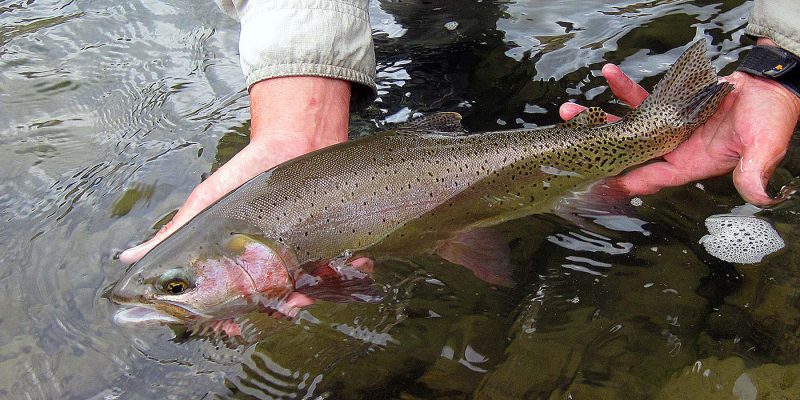Late Fall Float Trips
Posted on January 30th, 2021
Late Fall Float Trips: Introduction
Late autumn begins when nights begin falling below freezing most nights rather than just occasionally and the first snow that doesn’t all melt by midafternoon starts to fall now and again. Most years, the first week of October is when this occurs. After the switch flips there’s no reason to get out early in the morning save for hardcore anglers who want to try for one or two really big fish, even once the weather improves. The best fishing is typically from about 10:00AM through about 4:00PM.
Fishing is slow-paced at this time, with nymphs and streamers pounded in the deeper runs the most likely producers, but big numbers of rising trout also possible during good BWO hatches. This is the time of year when guides do most of their fishing. Little wonder. The big fish are eating, but there isn’t much work. Want to find out why the guides tend to like fishing during this period?

Late fall brown trout in spawning colors.
Late Fall Float Trips: Quick Facts
- Best Waters: All waters that remain high enough to float this late in the year can be excellent, but we generally stick close to home on the Yellowstone.
- Three Top Reasons to Come in Late Autumn: 1.) This is an excellent time to target big fish, 2.) Crowds are nonexistent, and 3.) the dry fly fishing can still be good for a couple hours each afternoon, and it’s generally much better than early spring.
- Three Top Reasons to Avoid Late Autumn: 1.) Weather and water conditions are wildly inconsistent and can be miserable: it can snow feet and remain below freezing for days at a time, or be too warm and bright. 2.) The numbers of fish caught on an average day are far lower than in summer, and 3.) Morning fishing is very slow most days.
- Perfect Clients: Experienced anglers who want to fish nymphs and streamers for larger fish, with a solid chance of some good dry fly fishing many afternoons.
- What Late Autumn Does Best: Produces big browns on their spawning runs and the rainbows that follow them looking for a meal of eggs.
Early Fall Float Trips
Posted on January 28th, 2021
Early Fall Float Trips: Introduction
As air and water temperatures cool in late August or the first week of September, flows continue to drop and aquatic insect hatches turn back on. The next month or so, basically the month of September, offers the best match-the-hatch fishing of the season. Even large trout sometimes rise to tiny flies, and good fishing is still possible with terrestrial dry flies as well.
Early fall float trips are all about flexibility. If it’s warm and bright, we’ll want to fish hoppers and ants for numbers of free-rising cutthroats on the upper Yellowstone or for rainbows and browns on the lower Stillwater. If it’s cool and gray, it might be prime time to float the Yellowstone’s “town section” or east of Livingston and hope for a few monsters.
This is rapidly becoming the second most-popular period for float trips in the region, after early summer, and for good reason: the weather and water conditions are great, the fish are fat and healthy, and the crowds of general tourists have departed. There can still be quite a few fishing boats out on the water, but except on Labor Day Weekend there are far fewer than during the summer. The Stillwater River in particular is far less busy once September rolls around than earlier.

This beautiful Yellowstone cutthroat ate a #18 Blue-winged Olive dry fly while Walter had the boat pulled into an eddy. The fish ran into the current and he had to hop into the boat to chase it down while his client’s reel screamed.
Here are a couple facts to keep in mind while you read this post:
- Early autumn is our favorite time to guide float trips on the Yellowstone and Stillwater Rivers (provided the Stillwater is high enough, sometimes it’s too low in the fall).
- While there aren’t any monster trout included on this page, every pictured fish here ate a dry fly. In fact, probably 80% of the trout we see on early fall float trips eat dries. Most of the rest eat emergers or small nymphs beneath these dries.
Late Summer Float Trips
Posted on January 28th, 2021
Late Summer Float Trips: Introduction
Late summer begins when rivers drop from the edges of the bushes and get slower. In the meantime, rivers turn crystal clear rather than green and aquatic insect hatches diminish, but terrestrial insects such as grasshoppers and ants begin blowing into the water in greater and greater numbers.
Some rivers get too low and in some cases too warm, but others become less challenging to fish, particularly in terms of the accuracy of casts required. While not quite so consistent as early summer, this period often offers easier fishing from a technical standpoint, and certainly offers slower-paced fishing, since flows are now low and slow enough to pick targets apart rather than blowing by.
For anglers who want to target larger fish on dry flies, as well as numbers on dries and small nymphs, this is a great period.
